This is the second installment of the “Controlling Chaos” series on entropy. For a list of all articles in this series, please click here.
One concept I discuss in both Scrabble books is entropy. Entropy may seem situational, but it can (and should) be applied universally: just as any candidate play can be assessed in terms of score and leave (equity), it can also be assessed in terms of entropy.
There are several types of entropy. Rack entropy refers to the entropy of a given leave, while board entropy refers to the range of scores available on a given board. Short term board entropy is also different than long term entropy, since the propensity to score next turn is often different than the propensity to score over the course of the entire game.
Rack Entropy
Rack entropy describes the variability of one’s remaining tiles to score well. While certain leaves consistently score well (such as CHOY), other leaves have both significant upside and downside, leading to a high entropy. For example, a fishing leave such as IORSTU has significant bingo potential, but with a bad draw (such as an I or R) the rack has limited bingo or scoring potential.
There are primarily two gaps when it comes to rack entropy: the gap between exchanging and scoring, and the gap between scoring and bingos. A leave such as AIIO or GLNTW has a high entropy because a good draw can make the rack score well (or even occasionally result in a bingo) while a bad draw forces you to exchange. Meanwhile, a leave such as EILNT is a good bingo leave but is usually relegated to ~20 point plays when it fails to result in a bingo. A leave such as AEIST crosses all three thresholds, possibly resulting in an exchange, medium scoring play, or a bingo.
Short term Board Entropy
Board entropy assesses the ability for the score to change on a specific board. High entropy boards have few scoring spots but many bingo lines. Board entropy can vary greatly both in the long and short term: bingo lines can be thought of as “currency” for short term entropy while space and board dynamics are the “currency” for long term entropy.
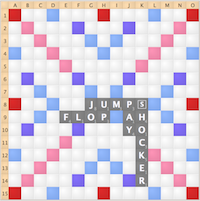 | 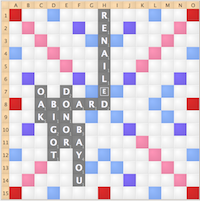 | 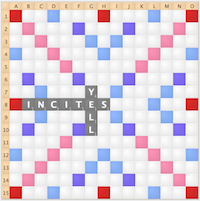 |
In all three diagrams, there is a high short term entropy, since there are a few very lucrative spots but not very many options if you don’t have the right tiles.
In Diagram 1, there is a lucrative S hook (SHOCKERS) as well as a few bingo lines through the E and R, and a lucrative spot for 5 letter words ending in E. However, if you don’t have any of these options, scoring will become very difficult.
In Diagram 2, there are a ton of bingo options, but not a heck of a lot of scoring options. While there will be a lot of high scoring plays, there will also be a lot of plays on this board that don’t score well at all.
Diagram 3 is an extreme example of short term entropy, with bingo options to the S in INCITES as well as the C, I, L, N, and S hooks, and a huge Z hook, but without those options you’re relegated to a ~20 point play.
Note that in all three positions, these openings are temporary. Access to the board is already being slightly restricted: the top left quadrant is blocked in Diagram 1, and a right angle threatens the bottom left in Diagrams 2 and 3. This is where long term entropy comes in.
Long term Board Entropy
Long term board entropy is different than short term board entropy in that it measures the ability for the board to score a lot of points over the many turns into the future rather than just the next turn or two. It is a measure of both you and your opponent’s ability to control space: either in terms of restricting access to certain parts of the board, or in some rare cases, restricting the trailing player’s ability to create new, unblockable bingo lines (such as unblockable S-hooks)
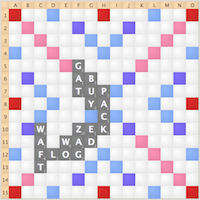 | 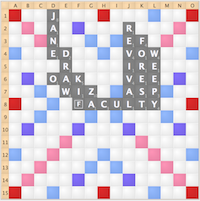 |
 |  |
In Diagram 1, there are is both short and long term entropy, with a ton of bingo lines for 7s with an S (although with a random rack this is unlikely, at this point both players rarely have random racks) as well as long term entropy, since all four quadrants are still open. Since bingos are inevitable, the right side and top of this board will eventually become open, thus the potential for massive swings is significant.
In Diagram 2, the entropy is not very severe at all since there isn’t much potential for a bingo (since both ranges seem random) but each quadrant is very open and accessible. The zipper on the top of the board isn’t very effective because lots of bingos end in R and ES, thus making it very difficult to block the board, and thus very difficult to restrict variance.
In Diagram 3, while there is a very low short term entropy, there is a very high long term entropy. While it is hard to bingo, it is very hard (and foolish) to try to block this board down, and either the C in FACULTY or the S-hook in SOAK will result in bingos eventually.
Myths about Entropy:
Since entropy is such a new concept, many people have errant beliefs about entropy. The most common misnomer is that entropy measures the propensity to score, rather than the propensity for the score to change. Positions where both players will often score well does not imply a high entropy. Here are some basic myths about entropy:
• Entropy measures the propensity to score. Entropy is not a measure of the ability to score points: it is a measure of the propensity for the score to change. Positions where both players will often score well does not imply a high entropy: high entropy positions are positions where both high and low scores are possible, but not much in between.
• “Taking a shot to end the game” or “Taking a risk because you can afford it”. These ideas are completely wrongheaded and are diametrically opposed to what you should be doing whenever you have an advantage. When ahead, you want to minimize risk and decrease entropy, and when behind, you want to encourage risk and increase entropy.
• All strong bingo racks have high entropy. Extremely strong racks or strong racks on poor scoring boards actually have a fairly low entropy, since a bingo is extremely likely or failing to draw a bingo is insignificant. High entropy not only requires the possibility of extremely good outcomes: it also requires the possibility of bad outcomes.
• All scoring racks have low entropy. Especially when there is one difficult, high scoring spot or significant bingo potential, scoring racks can often have lots of entropy. This is especially true with setups or fishes where you need one tile to hit a very high scoring play.
• Entropy is a concept stemming from fear. While many players may go overboard and block bingo lines, X spots, and higher scoring plays out of fear, entropy is still a real, mathematical concept used in many games and sports. While it might not be pleasing to fans and spectators, entropy is simply part of basic game fundamentals.
• Entropy is a concept for special situations. Entropy is not a concept: it is a metric. Just as one considers the equity of every play, they should also consider its entropy. While large differences in equity usually overrule equity, 5 or 10 point equity differences can easily be made up for if the entropy is more desirable.
• Blocking scoring spots decreases entropy. While this is sometimes true for short term entropy, entropy is not a measure of the ability to score: it’s a measure of the “variance” of one’s ability to score, and often times scoring spots decrease that variance, since they serve as a stopgap between bingos and ugly racks. Blocking scoring spots usually does not decrease entropy: in fact, many times it actually serves to increase entropy.
• Entropy only is based on score. Controlling entropy depends on other factors such as your tiles, the tile pool, and point spacing (which will be discussed in a future article). The potential of attaining a 70 point bingo is far more significant when the average non-bingo scores 20 points rather than 40 points.
